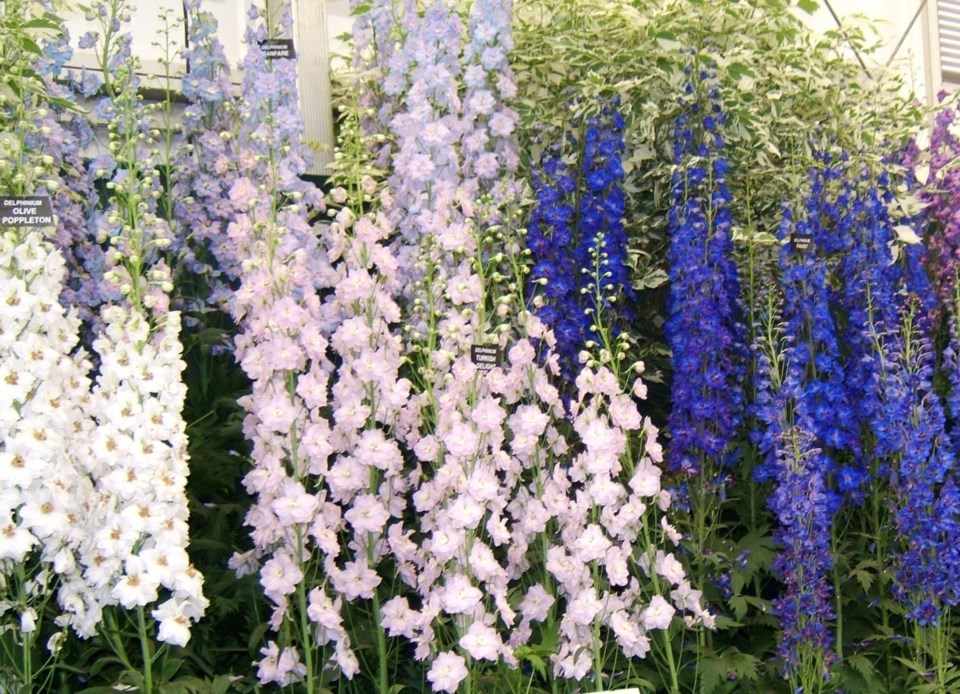Combating the red lily beetle was taking too much of my time (a story for another time) and I decided to replace my modest two-metre (10-foot) lily border with a perennial that requires less care. I decided on delphiniums.
There are over 300 species of annual and perennial delphiniums, found throughout the northern hemisphere and in the high mountains of tropical Africa. The genus name, Delphinium, comes almost directly from the Greek delphínion meaning dolphin, about the flower bud’s resemblance to said cetacean. A common name is larkspur which describes the part of the flower and flower bud that juts out behind the flower, resembling a lark’s hind claw.
The plant we’re most familiar with on the Prairies is the result of more than a century of hybridization involving the tall delphinium (D. elatum) and other delphinium species. The wild D. elatum is an upright herbaceous perennial, reaching close to 6 feet (1.8 m) with spikes of blue or purple single flowers. What all the hybridizing has done is introduce a wider colour range, including white, pink, lavender and scarlet as well as purple and blue; large (up to 7.5 cm / 3 inch wide) single, semi-double and double flowers; and a wider range of heights from 60 cm to 2.5 metres (2-8+ feet). The green leaves are deeply divided with three to seven lobes. Flowering begins in July and continues into August and September.
A word of caution – like other members of the Ranunculus family, all parts of the delphinium are poisonous. Though not reported to cause skin irritation, the most common symptoms of consuming delphiniums include nausea, vomiting and diarrhea. Severe poisoning can cause respiratory and cardiac failure, seizures and even death. Wear gloves or wash your hands thoroughly after handling plants. My advice – plant delphiniums in the middle to rear of the border.
The flowering stems are hollow and prone to breaking in strong wind and heavy rain. Tall varieties especially will require staking, if not in a sheltered location. Install stakes early in the season, as stems are emerging.
Delphinium spikes make nice cut flowers – cut when one-third of the flowers are open. After flowering, cut stems down to just a few centimetres above the ground – this will encourage more flowering stems to develop. In the fall, cut the plants down even with the soil surface.
I decided to grow my delphiniums from seed. I chose three pink-to-mauve Millennium series varieties (New Zealand Delphiniums, formerly Dowdeswell Delphiniums) of various heights to add interest and an extended bloom time. Some sources said that delphinium seed needs to be cold stratified, but I sowed mine in late February, very shallowly, directly into moist soil-less medium. They all germinated over 10-14 days. Once all the seedlings reached at least two true leaves, I transplanted them into a tray with 2.5 cm (1 in.) cells. After they were hardened off, I planted the seedlings in the garden in full sun in the first week of June. Following some benign neglect, I discovered that they needed to be kept evenly moist (but with no standing water) – a generous layer of organic mulch helped keep the soil moist.
While plants have the potential to spread up to a meter (3 ft) in diameter, I’ve planted them closer, at 50 cm (1.5 ft) apart, to account for some winter losses. If they all survive, I’ll end up digging up a few to give to friends.
Delphiniums can also be propagated by division. This is best done in early spring when the shoots are just emerging and allow enough time for divisions to become established over the summer. Dig up the plant and, using a sharp knife, cut it into sections, ensuring each division has roots and shoots.
Powdery mildew can be a problem. Some varieties are less susceptible (e.g., Pacific Giant series). The usual precautions include watering the ground, rather than the leaves; watering early in the day to allow surfaces to dry out during the day; and watering only as necessary. Preventative treatment includes spraying with copper sulfate compounds.
My delphiniums have provided the grey garden slugs (Deroceras reticulatum) a new addition to their usual buffet of hostas and other greens. These can be kept in check with a regular application of slug bait (according to label instructions), finely broken up egg shells and diatomaceous earth. Another pest to watch out for is the delphinium worm, the larval form of the delphinium leafier moth (Polychrysia Esmeralda). The 1.5 to 2 cm (0.6-0.75 in.) worms are green, the same colour as the leaf, so difficult to spot, but their damage is obvious – chewed off flower buds and top growth; feeding damage on leaves; folded, seemingly glued-together leaves; and tiny black pellets (insect poop) scattered on the leaves. Fortunately, there is only one generation per year. Control measures include (1) cutting plants down in the spring to 8 cm (3 in.) once they reach 15 cm (6 in.) to remove any hatchlings (throw cutting in the garbage) – this gets rid of the worm stage; (2) periodically scout for worms and remove by hand (squish), or spray with insecticidal soap or Bacillus thuringiensis (BT); and (3) since moths lay their eggs in the hollow stems, cut the stems even with the ground and remove all plant material (add to garbage, not compost) to eliminate overwintering habitat.
Erl gardens in Saskatoon.
This column is provided courtesy of the Saskatchewan Perennial Society (SPS; [email protected]). Check our website () or Facebook page () for a list of upcoming gardening events.




